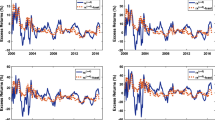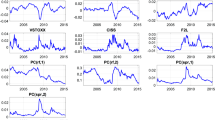Abstract
Amidst the lack of consensus from previous academic studies, this paper contributes to existing literature by further examining the commencement date of the Sovereign Debt Crisis for the Greek economy. The contribution of this paper purports that the contentious issue of the start of the Greek crisis was taking place much earlier than reported by previous research. Empirical results from this paper challenge earlier studies that may have underestimated the impact of the degree of persistence in the volatility of bond returns. This analysis uses monthly 10-year Greek government bond data and three independent structural break model tests which allow for the detection of possible endogenous break dates to capture the beginning of the crisis. Each model provides empirically plausible and robust frameworks for examining the volatility of bond returns in an evolving time series behaviour. Ultimate results from a series of autoregressive EGARCH estimations, with and without dummy variables for break dates are compared. The dummy variables are incorporated within the coefficients of the mean and variance equations to validate the structural breaks in each series. Overall results show a significant presence of nonconsistent parameters capturing a structural break in the time series sample. The detection of this break, November 2009, represents a major regime change triggered by the start of the debt crisis for the Greek economy. Crucially, research implications of such excess volatilities in sovereign bond markets have poignant implications for regulators, investors and portfolio risk managers alike.






Similar content being viewed by others
References
Bai J, Perron P (2003) Computation and analysis of multiple structural change models. J Appl Econ 18:1–22
Belkin P, Weiss M, Nelson R, Darek E (2012) The eurozone crisis: overview and issues for congress. Congr Res Serv Rep R42377
Bollerslev T (1986) Generalized autoregressive conditional heteroskedasticity. J Econ 72:307–327
Cappiello L, Engle R, Sheppard K (2006) Asymmetric dynamics in the correlations of global equity and bond returns. J Financ Econ 4:537–572
Cecchetti, S., Flores-Lagunes, A., & Krause, S. (2006). Assessing the Sources of Changes in the Volatility of Real Growth. The National Bureau of Economic Research, Working Paper , No.11946.
Covarrubias G, Ewing B, Hein S, Thompson M (2006) Modeling volatiliy changes in the 10-year treasury. Phys A Stat Mech Appl 369:737–744
Cunado, J., Gomez Biscarri, J., & Perez de Garcia, F. (2004). Structural Changes in Volatility and Stock Market Development. Phys A, 737–744
De Goeij P, Marquering W (2004) Modeling the conditional covariance between stock and bond returns: a multivariate GARCH approach. Journal of Financial Econometrics 2:531–564
Economic Research. (2015, March 13). Retrieved March 13, 2015, from FRED Federal Reserve Bank of St.Louis: http://research.stlouisfed.org/fred2/series/IRLTLT01GRM156N/downloaddata
Fang W, Miller S (2008) The great moderation and the relationship between output growth and its volatility. South Econ J 74:819–838
Fang W, Miller S (2009) Modelling the volatility of real GDP growth: the case of Japan revisited. World Econ 21:312–324
Glosten L, Jagannathan R, Runkle D (1993) On the relation between the expected value and the volatility of the nominal excess return on stocks. J Financ 48:1779–1801
Hamilton J (1989) A new approach to the economic analysis of nonstationary time series and the busines cycle. Econometrica 57:357–384
Hammoudeh S, Li H (2008) Suddden changes in volatility in emerging markets: the case of Gulf Arab stock markets. Int Revenue Financ Anal 17:47–63
Hammoudeh S, Yuan Y (2008) Metal volatility in presence of oil and interest rate shocks. Energy Econ 30:606–620
Hillebrand E (2005) Neglecting parameter changes in GARCH model. J Econ 129:121–138
Kasimati E (2011) Did the climb on the Greek sovereign spreads cause the devaluation of Euro? Appl Econ Lett 18:851–854
Lee J, Strazicich M (2003) Minimum LM unit root test with two structural breaks. Rev Econ Stat 63:1082–1089
Liu J, Wu S, Zidek J (1997) On segmented multivariate regression. Stat Sin 7:497–525
Malik F (2003) Sudden changes in variance and volatility persistence in foreign exchange markets. J Multinatl Financ Manag 13:217–230
Malik F, Ewing B, Payne J (2005) Measuring volatility persistence in the presence of sudden changes in the variance of canadian stock returns. Can J Econ 38:1037–1056
Mandelbrot B (1963) The variation of certain speculative prices. J Bus 36:394–419
Mikosh T, Starica C (2004) Non-stationarities in financial time-series, the long-range dependence and the IGARCH effects. Rev Econ Stat 86:378–390
Nelson D (1990) Stationary and persistence in the GARCH(1,1) model. Econometric Theory 6:318–334
Perron P, Vogelsang T (1992) Nonstationary and level shifts with an application to purchasing power parity. J Bus Econ Stat 10:301–320
Rapach D, Strauss M (2008) Structural breaks and GARCH models of exchange rate volatility. J Appl Econ 23:65–90
Salisu A, Fasanya I (2013) Modelling oil price volatility with structural breaks. Energy Policy 52:554–562
Tamakoshi G (2011) European sovereign debt crisis and linkages of long-term government bond yields. Econ Bull 31(3):2191–2203
Tamakoshi G, Hamori S (2014) Greek sovereign bond index, volatility and structural breaks. J Econ Financ 38:687–697
Wang P, Moore T (2009) Sudden changes in volatility: the case of five central European stock markets. J Int Finan Mark Inst Money 19:33–46
Author information
Authors and Affiliations
Corresponding author
Rights and permissions
About this article
Cite this article
Budd, B.Q. Structural break tests and the Greek sovereign debt crisis: revisited. J Econ Finan 40, 607–622 (2016). https://doi.org/10.1007/s12197-015-9339-1
Published:
Issue Date:
DOI: https://doi.org/10.1007/s12197-015-9339-1




